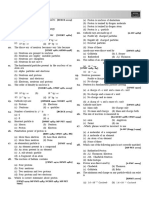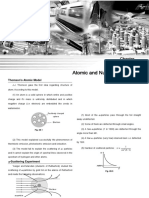0 ratings0% found this document useful (0 votes)
2 viewsSCIENCE NOTES
The document outlines the evolution of atomic models, starting from Democritus's idea of indivisible particles to the plum pudding model by Thomson and Rutherford's nuclear model. It highlights Niels Bohr's advancements in 1913, introducing quantized energy levels and electron orbits, while also addressing the limitations of these models in explaining phenomena for larger atoms. Additionally, it discusses quantum numbers and their significance in describing electron behavior and energy levels within an atom.
Uploaded by
jnemtaCopyright
© © All Rights Reserved
Available Formats
Download as PDF, TXT or read online on Scribd
0 ratings0% found this document useful (0 votes)
2 viewsSCIENCE NOTES
The document outlines the evolution of atomic models, starting from Democritus's idea of indivisible particles to the plum pudding model by Thomson and Rutherford's nuclear model. It highlights Niels Bohr's advancements in 1913, introducing quantized energy levels and electron orbits, while also addressing the limitations of these models in explaining phenomena for larger atoms. Additionally, it discusses quantum numbers and their significance in describing electron behavior and energy levels within an atom.
Uploaded by
jnemtaCopyright
© © All Rights Reserved
Available Formats
Download as PDF, TXT or read online on Scribd
You are on page 1/ 3
SCIENCE NOTES - He then made the plum
pudding model of the atom
in 1904. “The electrons are
like negatively charged
THE BOHR MODEL AND plums stuck to a positively
THE QUANTUM charged pudding.”
MECHANICAL MODEL OF
- In 1911, Lord Ernest
THE ATOM: Rutherford discovered the
nucleus. Made up of
EARLIER ATOMIC MODELS +charged particles at the
- The first idea of the atom was center of the atom, which he
proposed by Democritus, a found through his gold foil
Greek philosopher. experiment. He called it the
- “The world is made up of nuclear model, stating,
tiny indivisible particles “-charged electrons
called atomos.”, later it was surround the +charged
coined as the atomism nucleus at the center of the
theory. atom.”
- In 1803, John Dalton BOHR’S MODEL
proposed the solid sphere - Scientists found out that the
model. nuclear model CANNOT
- “The atom is a uniform solid explain certain physical
sphere similar to a billiard observations such as the
ball” “indivisible and capacity of atoms to emit
eternal” light. It cannot account for the
stability of the atom.
- During the Industrial - So, in 1913, Niels Bohr
Revolution of the 19th improved Rutherford’s model
century , atomism saw a by adding orbits.
resurgence. It acquired - “Electrons only move
experimental evidence when around the nucleus in fixed
Sir Joseph John Thomson circular orbits.”
discovered the electron in - Orbits are also known as
1897. energy levels (n). Its values
are any whole numbers from 1,
2, and onward. Example, the FOLLOW-UPS:
first orbit of the first circle is
also known as the first energy Alpha particles - +charged
level (n=1). N is also known as radioactive protons that has
the principal quantum 4x the mass of a hydrogen
number. atom
- This model could account for - Lines with corresponding
light emissions because the wavelengths indicate the
presence of orbits can explain release of energy
the absorption of energy of an
atom. The energy - Although, there is a fallback to
transformations that result in the Bohr’s Model, which is, it
the emission of light is due to fails to explain phenomena
the movement of an electron for larger atoms, and it
from one atomic orbit to a cannot account for atoms
higher atomic orbit, and back. with more than one electron.
- When an electron absorbs - The emission of light due to
energy, it moves to an atomic excitation of electrons is the
orbit with higher energy. THe reason why elements emit
original atomic orbit is called characteristic light. For
the ground state. The higher example, calcium releases
A.O. is called the excited orange light, sodium
state, which is unstable. releases yellow light and
copper releases green light.
- An electron can only jump in a This is how fireworks get their
certain orbit. Instead of colors.
having continuous energy
levels, Bohr’s Model introduces - The collective term for protons
the concept of quantized and neutrons is called the
energy levels. nucleon
- Protons tell us the identification
of an element.
- Each line in the atomic spectra
- Electrons tell us the chemical
corresponds to a definite
properties of an atom.
energy transformation within - Valence electron is the outermost
the atom. part of an electron
ATOMIC ORBITALS AND orbital. It represents the
energy needed to maintain the
QUANTUM NUMBERS
attraction of an electron in an
orbital and proton in the
- In the quantum mechanical nucleus. Hence,
model, an electron orbiting the The value of n increases
nucleus will have a unique set with distance from the
of four quantum numbers. The nucleus.
set of quantum numbers acts
as a sort of address for each - The maximum number of
electron. electron in a shell can contains
is computed by 2n^2, where n
is the PQN.
PRINCIPAL QUANTUM NUMBER
(n) AZIMUTHAL QUANTUM NUMBER
- Refers to the distance of the - In the quantum mechanical
electron to the nucleus model, a shell consists of
- Also known as the shell. subshells. They describe the
- The values of n are 1,2,3, and shape of the atomic orbital.
so on. It is also equal to the The subshell is also known as
period where the element the Azimuthal Quantum
belongs. Number (l)
(As the value of n increases, *also called the orbital
the electron becomes farther angular momentum
away from the nucleus.) quantum number
- This set of electrons of orbitals - The values of l are zero to
represents the boundary n(PQN)-1. Each value of l
surface diagrams. It encloses corresponds to a subshell
a region of space where shape.
electrons are usually found
90% of the time.
- The Principal Quantum
Number is also directly related
to the main energy of an
You might also like
- Science Stage 8 Sample Paper 2 - tcm143-59570580% (5)Science Stage 8 Sample Paper 2 - tcm143-59570523 pages
- Intro Quantum Numbers Energy Level DiagramsNo ratings yetIntro Quantum Numbers Energy Level Diagrams38 pages
- Module 1 Electronic Structure of Matter STUDENTSNo ratings yetModule 1 Electronic Structure of Matter STUDENTS106 pages
- Final Quantum Mechanical Model of An Atom AutosavedNo ratings yetFinal Quantum Mechanical Model of An Atom Autosaved85 pages
- SCIENCE_Q2-dont-even-try-to-open-this-if-youre-ANGELINENo ratings yetSCIENCE_Q2-dont-even-try-to-open-this-if-youre-ANGELINE33 pages
- CH B1. Summary-Models of The Atom WRKSHTNo ratings yetCH B1. Summary-Models of The Atom WRKSHT3 pages
- Final-Quantum-Mechanical-Model-of-an-Atom-AutosavedNo ratings yetFinal-Quantum-Mechanical-Model-of-an-Atom-Autosaved85 pages
- Atom Models: From Democritus To Modern ModelNo ratings yetAtom Models: From Democritus To Modern Model77 pages
- The Bohr Model and The Quantum Mechanical Model of The Atom: Lesson 1No ratings yetThe Bohr Model and The Quantum Mechanical Model of The Atom: Lesson 132 pages
- Unit 2 (Structure and Properties of Matter) NotesNo ratings yetUnit 2 (Structure and Properties of Matter) Notes16 pages
- G9 - Quarter 3 - The Quantum Mechanical ModelNo ratings yetG9 - Quarter 3 - The Quantum Mechanical Model95 pages
- Momentum of The Particles at The Same TimeNo ratings yetMomentum of The Particles at The Same Time2 pages
- CHM 101 Atoms, Molecules and Structure - BangbadeNo ratings yetCHM 101 Atoms, Molecules and Structure - Bangbade36 pages
- Images of The Invisible Powerpoint Presentation21No ratings yetImages of The Invisible Powerpoint Presentation2121 pages
- ORGANIC AND INORGANIC CHEMISTRY REVIEWER - COPYRIGHT@villanuevarNo ratings yetORGANIC AND INORGANIC CHEMISTRY REVIEWER - COPYRIGHT@villanuevar5 pages
- An Atom Contains Electrons - PresentationNo ratings yetAn Atom Contains Electrons - Presentation21 pages
- Science Pocket Lesson in General Physics 2 1 PDF100% (1)Science Pocket Lesson in General Physics 2 1 PDF42 pages
- Nuclear Physics: Basic Professional Training Course Module I Nuclear Physics and Reactor TheoryNo ratings yetNuclear Physics: Basic Professional Training Course Module I Nuclear Physics and Reactor Theory50 pages
- LESSON 3 (The Number of Subatomic Particles in Atoms, Ions and IsotopesNo ratings yetLESSON 3 (The Number of Subatomic Particles in Atoms, Ions and Isotopes50 pages
- Rutherford, Radioactivity, and The Atomic NucleusNo ratings yetRutherford, Radioactivity, and The Atomic Nucleus30 pages
- Atomic Structure Bohr Model Periodic Trends Student Notes Practice Problems 1No ratings yetAtomic Structure Bohr Model Periodic Trends Student Notes Practice Problems 110 pages
- 2.2 Atomic structure and the Periodic Table QPNo ratings yet2.2 Atomic structure and the Periodic Table QP7 pages
- Chapter 2 The Chemical Basis of Life: Campbell's Biology: Concepts and Connections, 7e (Reece Et Al.)100% (2)Chapter 2 The Chemical Basis of Life: Campbell's Biology: Concepts and Connections, 7e (Reece Et Al.)14 pages
- Atomic and Nuclear Physics: Thomson's Atomic ModelNo ratings yetAtomic and Nuclear Physics: Thomson's Atomic Model23 pages
- Olved Xamples: Chapter # 46 The NucleusNo ratings yetOlved Xamples: Chapter # 46 The Nucleus18 pages
- Midterm Test Exercise Sem 1 Ay 2024-2025 2No ratings yetMidterm Test Exercise Sem 1 Ay 2024-2025 26 pages
- David L. Bergman and Charles W. Lucas, JR - Credibility of Common Sense ScienceNo ratings yetDavid L. Bergman and Charles W. Lucas, JR - Credibility of Common Sense Science17 pages

























































































